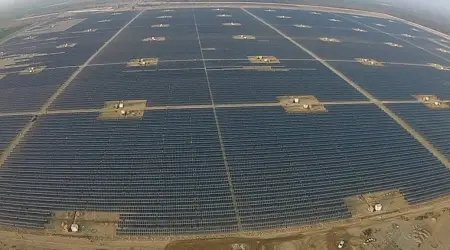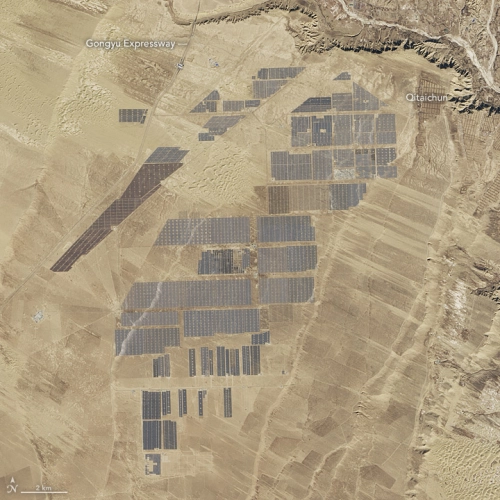
Amid growing concerns about climate change and the need to reduce greenhouse gas emissions, solar energy has emerged as a key solution to address global energy and environmental challenges.
In this context, China has emerged as one of the world leaders in the development and implementation of solar energy, playing a crucial role in the transition towards a more sustainable future focused on renewable energy.
The rise of solar energy in China
Over the past few decades, China has seen extraordinary growth in the solar energy sector. This rapid development has been driven by a combination of factors, including favorable government policies, technological advances, and a growing awareness of the importance of environmental sustainability.
One of China's major contributions to the global solar market has been its large-scale manufacturing capabilities for solar panels. The country has become the world's leading producer of photovoltaic panels, driving a significant reduction in the costs of solar technology globally.
Chinese companies currently dominate the global solar panel manufacturing market, which has enabled a massive expansion of installed solar capacity around the world.
Previous energy context
Prior to this push in China's solar energy development policy, the country relied heavily on conventional energy sources, such as coal, oil and natural gas, to meet its energy needs. China is the world's largest consumer and producer of coal, and for decades, coal has been the country's main energy source, accounting for the majority of its electricity generation capacity.
This dependence on coal had several implications for the country, including air and water pollution, greenhouse gas emissions, and the generation of solid waste. Furthermore, the exploitation and consumption of coal contributed to environmental degradation and the scarcity of natural resources in some regions of China.
Although China has also depended on oil and natural gas to meet a portion of its energy demand, these sources have not been sufficient to fully supply the country's growing energy needs, leading to the import of large quantities of oil and gas. .
Before the rise of solar energy, China had already been building and operating nuclear plants in several regions of the country. It is also worth mentioning that renewable energies, including hydropower and wind energy, have always had a presence in China's energy mix, even though their contribution was relatively limited compared to conventional energy sources.
Below we attach a table showing the evolution of the use of China's energy resources:
| Energy resource | 1980 | 2000 | 2020 |
| Coal | 70% | 70% | 57% |
| Petroleum | 20% | 20% | 20% |
| Gas natural | 1% | 2% | 8% |
| Nuclear energy | 0% | 1% | 5% |
| Hydroelectric power | 8% | 7% | 9% |
| Solar energy | <1% | <1% | 4% |
| Other renewables | 1% | 2% | 6% |
Support policies and environmental commitments
The Chinese government has played a critical role in the development of solar energy through a series of supportive policies including subsidies for the installation of solar systems, guaranteed feed-in tariffs for solar energy generated, and ambitious installed capacity targets.
For example, China has set a goal of reaching total solar capacity of 1,200 gigawatts by 2030, which represents a significant expansion from its current capabilities.
In addition to its solar energy goals, China has also committed to reducing its carbon emissions and increasing its use of renewable energy as part of its efforts to address climate change. For this reason, China has continued to invest in nuclear energy. The country has announced the construction of new nuclear plants and investment in advanced nuclear technologies, such as new generation reactors and nuclear fusion reactors.
These commitments are reflected in its participation in the Paris Agreement and in its own national sustainable development goals.
The Paris Agreement is an international climate change treaty that seeks to limit global temperature rise to less than 2°C above pre-industrial levels, and pursues efforts to limit it to 1.5°C.
Implementation of large-scale solar projects
The Asian giant has carried out numerous large-scale solar projects across the country. These projects include solar parks, solar farms and distributed photovoltaic systems in urban and rural areas. Some of the largest are:
Granja solar de Longyangxia
 Located in Qinghai province, the Longyangxia Solar Farm is one of the largest solar projects in the world.
Located in Qinghai province, the Longyangxia Solar Farm is one of the largest solar projects in the world.
With an installed capacity of more than 850 megawatts (MW), this solar farm covers an extensive area of 27 square kilometers and consists of millions of solar panels arranged in rows.
The energy generated by this solar farm is used to supply both the surrounding areas and other regions of China.
Datong Solar Park
The Datong Solar Park, located in Shanxi province, is another of the largest solar projects in China.
With an installed capacity of around 1 gigawatt (GW), this solar park is part of the Chinese government's efforts to promote clean energy in a region that traditionally relied on coal mining.
Tengger Solar Park
This solar plant is located in the Inner Mongolia autonomous region, the Tengger Solar Park is another of the most notable solar projects in China.
It has an installed capacity of approximately 1.5 gigawatts (GW), being part of the country's efforts to harness its vast solar energy potential in the western and central regions.
Technological Innovation and Future Development
In parallel, China is investing heavily in research and development of advanced solar technologies, such as concentrated solar power (CSP) and the integration of energy storage systems. These technologies have the potential to improve the efficiency and reliability of solar energy, as well as address the challenges associated with the intermittency of solar generation.
In addition, the Asian country is actively exploring opportunities to integrate solar energy into other sectors, such as agriculture, construction and transportation.
For example, agricultural solar energy systems are being developed that combine electricity generation with crop production, providing additional benefits in terms of food security and poverty alleviation in rural areas.
Future challenges and opportunities
Despite the impressive progress made in solar energy development in China, the country still faces several challenges on its path to a cleaner, more sustainable economy.
These challenges include effectively integrating solar energy into the electrical grid, managing the variability of solar generation, and mitigating the environmental impacts associated with the manufacturing and disposal of solar panels.
However, as China continues to advance its transition to cleaner, more sustainable energy, new opportunities are also opening up for innovation, international collaboration and economic growth.
With its continued commitment to solar energy and renewable energy in general, China is positioned to continue playing a crucial role in the transformation of the global energy system towards a more sustainable and renewable energy-focused future.